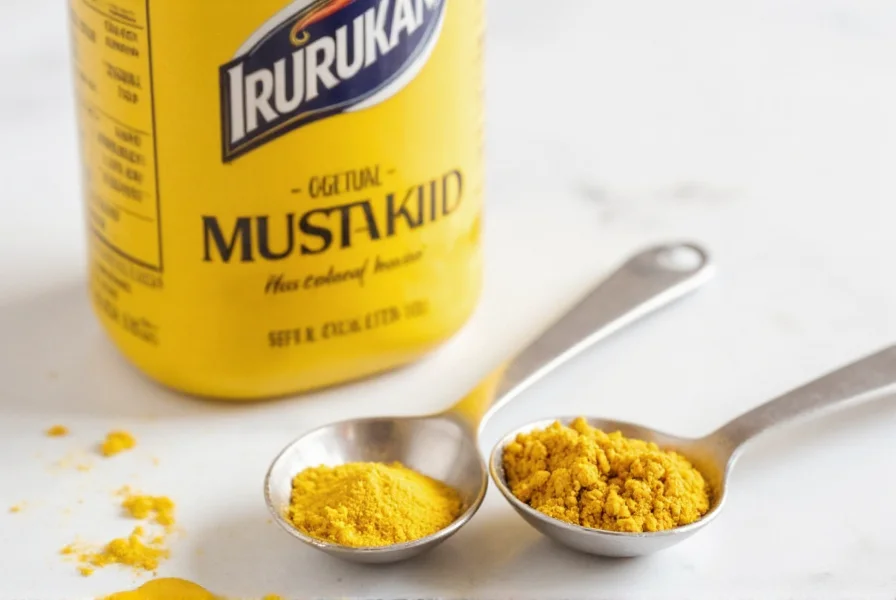When you're in the middle of cooking and realize you're out of mustard powder, knowing reliable alternatives can save your recipe. Mustard powder, also called dry mustard, provides that distinctive tangy flavor in everything from salad dressings to meat rubs. Understanding what makes an effective substitute requires knowing both the flavor profile and functional properties of mustard powder in recipes.
Why You Might Need a Mustard Powder Substitute
Mustard powder serves multiple purposes in cooking. It adds tanginess, helps emulsify dressings, enhances other flavors, and contributes to the texture of certain dishes. When you don't have it on hand, finding the right replacement depends on whether you need its flavor, its thickening properties, or both. Many home cooks search for mustard powder substitute in recipes when they're mid-recipe and need immediate solutions.
Top Mustard Powder Alternatives Explained
Prepared Yellow Mustard
This common refrigerator staple makes an excellent mustard powder substitute for baking and dressings. Since it already contains water and vinegar, you'll need to adjust liquid content in your recipe.
Conversion: Use 1 tablespoon of yellow mustard for every 1 teaspoon of mustard powder. Reduce other liquids by 1-2 teaspoons to compensate for the added moisture.
Best for: Macaroni salad, barbecue sauces, and sandwich spreads where a mild mustard flavor works well.

Dijon Mustard
Dijon offers a more complex flavor profile that works well as a mustard powder alternative for baking and sauces. It contains wine or verjuice, which adds depth but may alter the final flavor slightly.
Conversion: Substitute 1 tablespoon of Dijon mustard for each teaspoon of mustard powder. Consider reducing other acidic ingredients slightly.
Best for: Creamy sauces, vinaigrettes, and meat marinades where a sharper flavor enhances the dish.
Whole Grain Mustard
This substitute maintains texture while delivering flavor. It's particularly useful when you need that signature mustard taste without the smooth consistency of powder.
Conversion: Use 1 tablespoon of whole grain mustard per teaspoon of mustard powder. You may want to blend it for smoother applications.
Best for: Salad dressings, potato salads, and recipes where visible mustard seeds add visual appeal.
Horseradish
When you need the sharp bite of mustard without the distinctive mustard flavor, horseradish makes a functional substitute, especially in meat preparations.
Conversion: Use 1 teaspoon of prepared horseradish per teaspoon of mustard powder. Add a small amount of vinegar to mimic mustard's acidity.
Best for: Beef dishes, cocktail sauces, and recipes where heat is more important than mustard flavor.
Turmeric with Vinegar
This combination works only as a color substitute, not for flavor. Turmeric provides the yellow hue while vinegar adds necessary acidity.
Conversion: Use 1/4 teaspoon turmeric plus 1 teaspoon vinegar per teaspoon of mustard powder.
Best for: Situations where appearance matters more than flavor, like in certain cheese dishes where color is key but mustard flavor would be overpowering.
| Substitute | Ratio (for 1 tsp mustard powder) | Flavor Match | Best Applications | Liquid Adjustment |
|---|---|---|---|---|
| Yellow Mustard | 1 tbsp | Good | Dressings, sauces, baked goods | Reduce other liquids by 1-2 tsp |
| Dijon Mustard | 1 tbsp | Excellent | Cream sauces, marinades | Reduce acids slightly |
| Whole Grain Mustard | 1 tbsp | Very Good | Salads, dressings | None needed |
| Horseradish | 1 tsp + vinegar | Fair (heat only) | Meat dishes, cocktail sauce | Add vinegar as needed |
| Turmeric + Vinegar | 1/4 tsp + 1 tsp | Poor (color only) | Color-sensitive dishes | Adjust as needed |
Special Considerations for Different Recipes
For Baking and Dry Rubs
When substituting in dry applications like spice rubs or baked goods, liquid substitutes require careful adjustment. For mustard powder substitute measurements in dry rubs, consider making a paste with your liquid substitute and a small amount of oil before mixing with other dry ingredients. This prevents clumping and ensures even distribution.
For Salad Dressings and Marinades
Liquid mustard substitutes work particularly well here since dressings already contain liquids. When looking for a mustard powder substitute for pickling, Dijon or yellow mustard provide the necessary acidity without altering the pickling process significantly.
For Cheese Dishes
Cheddar cheese sauces and similar dishes often use mustard powder to enhance flavor without adding liquid. In these cases, a small amount of prepared mustard blended thoroughly works better than trying to use a dry substitute.
Creating Your Own Mustard Powder Substitute
If you frequently need mustard powder, consider making your own blend for future use. Combine 2 parts turmeric, 1 part paprika, 1/2 part garlic powder, and a pinch of cayenne. Store in an airtight container. While not identical to real mustard powder, this homemade mustard powder replacement works in a pinch for color and some flavor complexity.
When Substitutes Won't Work
Some recipes rely specifically on mustard powder's unique properties. In canning and pickling recipes designed for food safety, altering ingredients could create unsafe conditions. Similarly, in certain cheese ball recipes where mustard powder helps bind ingredients, liquid substitutes might make the mixture too wet. Always consider whether your mustard powder replacement ratio might affect the structural integrity of your dish.










 浙公网安备
33010002000092号
浙公网安备
33010002000092号 浙B2-20120091-4
浙B2-20120091-4